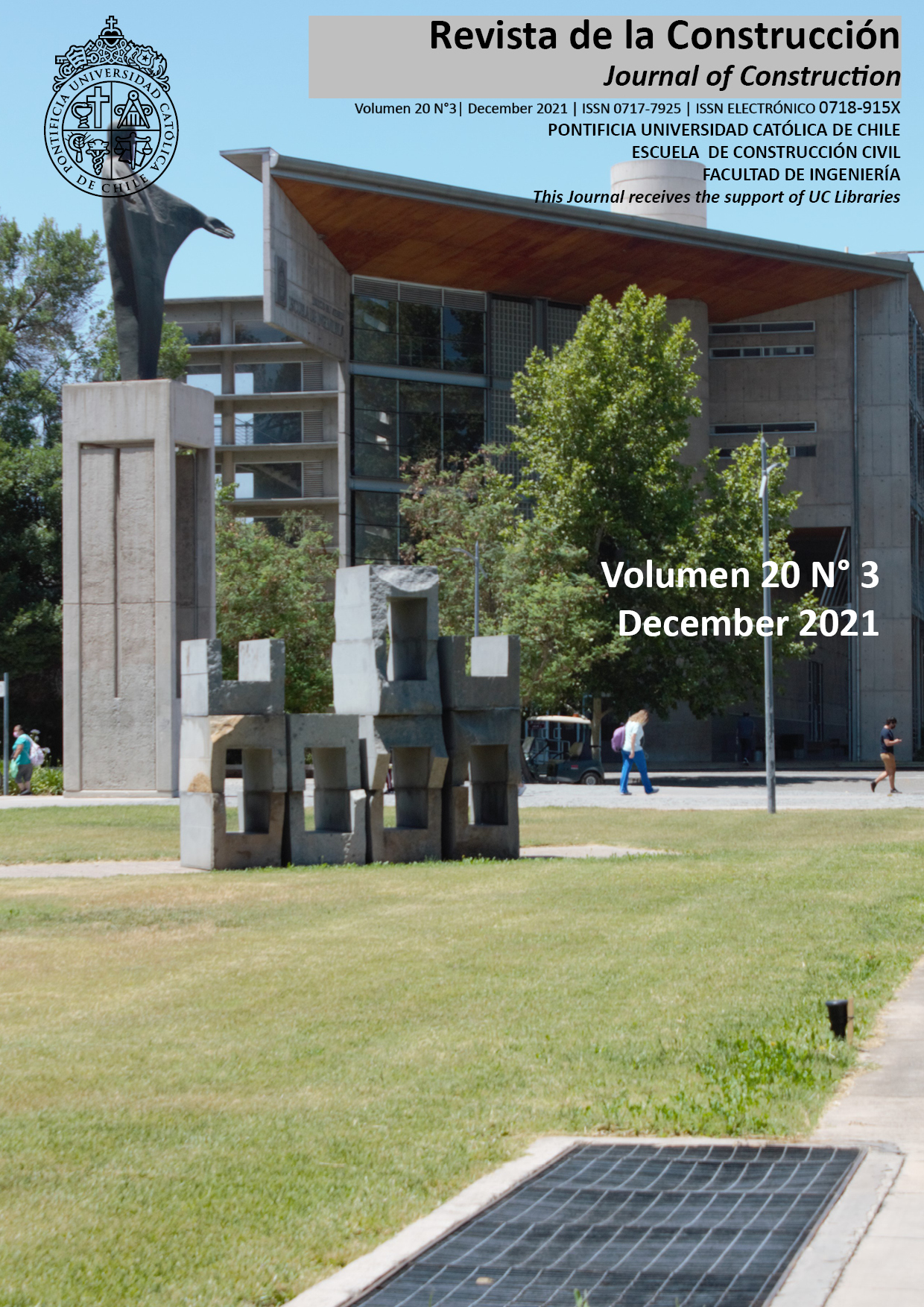Analytical study on the behavior of spirally welded steel columns
DOI:
https://doi.org/10.7764/RDLC.20.3.427Keywords:
ductility, non-linear, spirally welded column, bucklingAbstract
Spirally welded tube (SWT) members are predominantly used for offshore oil and gas transportation in the pipeline industry. The use of SWTs in construction is gaining attention with emerging and qualitative research. SWT columns have no parametric limitation in manufacturing. However, no specific research is available for the influence of helix angle in SWT columns as structural member. This investigation stresses on understanding the behavior of SWT columns with different helix angles. Seventy-two finite element (FE) models of SWT columns have been analyzed to study the influence of length to diameter (L/D) ratio, diameter to thickness (D/t) ratio and helix angle on the load-carrying capacity. Test results of two SWT columns available in the literature are used for validating the developed FE model. In addition, the capacity of the columns based on standard codes is computed and compared with the FE results. All the columns are axially compressed and the buckling and post-buckling behavior are simulated. Initial stiffness and ductility index of the columns are discussed. Helix angle between 40° to 50° are found to show the best results.
Downloads
References
ABAQUS 2013. Abaqus standard User’s manual, version 6.13, Dassault systemes. Abaqus User’s Guide.
AISI S100. (2007). North American Specification for the Design of Cold-Formed Steel Structural Members.
API 5L. (2013). Specification for Line Pipe, American petroleum institute, Washington DC. 45th Edition.
AS 1579. (2001). Australian Standard TM Arc-welded steel pipes and fittings for water and wastewater.
Aslani, F., Uy, B., Hicks, S., & Kang, W.-H. (2015). Spiral welded tubes - imperfections, residual stresses, and buckling characteristics. Proceedings of the Eighth International Conference on Advances in Steel Structures, 21-24 July 2015, Lisbon, Portugal, (September). https://doi.org/10.13140/RG.2.1.1399.7927/2
Aslani, F., Uy, B., Hur, J., & Carino, P. (2017). Behaviour and design of hollow and concrete-filled spiral welded steel tube columns subjected to axial compression. Journal of Constructional Steel Research, 128, 261–288. https://doi.org/10.1016/j.jcsr.2016.08.023
ASTM- A252. (2019). Standard Specification for Welded and Seamless Steel Pipe Piles. In Current. ASTM International, West Conshohocken, PA,. https://doi.org/10.1520/A0252-10.2
BS 5950 -5. (2006). Structural use of steelwork in building. Part 5, Code of practice for design of cold formed thin gauge sections. (January), 59.
EN 10219 -2. (2019). Cold formed welded structural hollow sections of non-alloy and fine grains.
EN 1993-1-1. (2011). Eurocode 3: Design of steel structures Part 1-1 General rules and rules for buildings.
Gunawardena, Y., & Aslani, F. (2018). Behaviour and design of concrete-filled mild-steel spiral welded tube short columns under eccentric axial compression loading. Journal of Constructional Steel Research, 151, 146–173. https://doi.org/10.1016/j.jcsr.2018.09.018
Gunawardena, Y., & Aslani, F. (2021a). Finite element modelling of concrete-filled spiral-welded mild-steel and stainless-steel tubes in flexure. Structures, 32(September 2020), 792–816. https://doi.org/10.1016/j.istruc.2021.03.056
Gunawardena, Y., & Aslani, F. (2021b). Finite element modelling of concrete-filled spiral-welded mild-steel tube short and long columns. Structures, 30(August 2020), 1020–1041. https://doi.org/10.1016/j.istruc.2021.01.074
Gunawardena, Y., & Aslani, F. (2021c). Finite element modelling of concrete-filled spiral-welded stainless-steel tube columns under concentric and eccentric axial loading. Structures, 33(October 2020), 1119–1143. https://doi.org/10.1016/j.istruc.2021.05.015
IS 5504. (1997). Indian standard specification for spiral welded pipes.
IS 801. (1998). Cold-Formed Light Gauge Steel Structural Members in General. Public Works.
ISO 3183. (2014). International Standard , Petroleum and natural gas industries - steel pipe for pipeline transportation systems.
Li, D., Uy, B., Aslani, F., & Hou, C. (2018). Numerical analysis of concrete-filled spiral welded stainless steel tubes subjected to compression. (Asccs), 365–371. https://doi.org/10.4995/asccs2018.2018.7200
Mahmoud, A., Torabian, S., Jay, A., Myers, A., Smith, E., & Schafer, B. W. (2015). Modeling protocols for elastic buckling and collapse analysis of spirally welded circular hollow thin-walled sections. Structural Stability Research Council Annual Stability Conference 2015, SSRC 2015, (March), 611–626. https://doi.org/10.13140/2.1.4893.7763
Martínez, M. M. (2019). Application of the beam method to structural calculation of the long cylindrical concrete shells in the work of Felix Candela. Revista de La Construccion, 18(1), 134–144. https://doi.org/10.7764/RDLC.18.1.134
Sadowski, A. J., Michael Rotter, J., Reinke, T., & Ummenhofer, T. (2015a). Analysis of variance of tensile tests from spiral welded carbon steel tubes. Construction and Building Materials, 75, 208–212. https://doi.org/10.1016/j.conbuildmat.2014.11.015
Sadowski, A. J., Van Es, S. H. J., Reinke, T., Michael Rotter, J., Nol Gresnigt, A. M., & Ummenhofer, T. (2015b). Harmonic analysis of measured initial geometric imperfections in large spiral welded carbon steel tubes. Engineering Structures, 85, 234–248. https://doi.org/10.1016/j.engstruct.2014.12.033
Van Es, S., Gresnigt, A. M. (Nol), Kolstein, H., & Bijlaard, F. S. K. (2013). Local Buckling of Spirally Welded Tubes - Analysis of Imperfections and Physical Testing. Proceedings of the International Offshore and Polar Engineering Conference.





